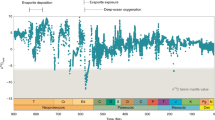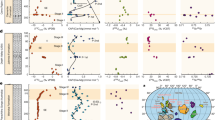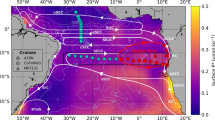Abstract
The North Pacific subtropical gyre (NPSG) plays a major part in the export of carbon and other nutrients to the deep ocean1. Primary production in the NPSG has increased in recent decades despite a reduction in nutrient supply to surface waters2,3. It is thought that this apparent paradox can be explained by a shift in plankton community structure from mostly eukaryotes to mostly nitrogen-fixing prokaryotes2,3,4. It remains uncertain, however, whether the plankton community domain shift can be linked to cyclical climate variability or a long-term global warming trend5. Here we analyse records of bulk and amino-acid-specific 15N/14N isotopic ratios (δ15N) preserved in the skeletons of long-lived deep-sea proteinaceous corals collected from the Hawaiian archipelago; these isotopic records serve as a proxy for the source of nitrogen-supported export production through time. We find that the recent increase in nitrogen fixation is the continuation of a much larger, centennial-scale trend. After a millennium of relatively minor fluctuation, δ15N decreases between 1850 and the present. The total shift in δ15N of −2 per mil over this period is comparable to the total change in global mean sedimentary δ15N across the Pleistocene–Holocene transition, but it is happening an order of magnitude faster6. We use a steady-state model and find that the isotopic mass balance between nitrate and nitrogen fixation implies a 17 to 27 per cent increase in nitrogen fixation over this time period. A comparison with independent records7,8 suggests that the increase in nitrogen fixation might be linked to Northern Hemisphere climate change since the end of the Little Ice Age.
This is a preview of subscription content, access via your institution
Access options
Subscribe to this journal
Receive 51 print issues and online access
$199.00 per year
only $3.90 per issue
Buy this article
- Purchase on Springer Link
- Instant access to full article PDF
Prices may be subject to local taxes which are calculated during checkout



Similar content being viewed by others
References
Emerson, S. et al. Experimental determination of the organic carbon flux from open-ocean surface waters. Nature 389, 951–954 (1997)
Karl, D. M., Bidigare, R. R. & Letelier, R. M. Long-term changes in plankton community structure and productivity in the North Pacific Subtropical Gyre: the domain shift hypothesis. Deep Sea Res. Part II 48, 1449–1470 (2001)
Corno, G. et al. Impact of climate forcing on ecosystem processes in the North Pacific Subtropical Gyre. J. Geophys. Res. 112, C04021 (2007)
Karl, D. et al. The role of nitrogen fixation in biogeochemical cycling in the subtropical North Pacific Ocean. Nature 388, 533–538 (1997)
Henson, S. A. et al. Detection of anthropogenic climate change in satellite records of ocean chlorophyll and productivity. Biogeosciences 7, 621–640 (2010)
Galbraith, E. D. et al. The acceleration of oceanic denitrification during deglacial warming. Nature Geosci. 6, 579–584 (2013)
Wilson, R. et al. Two-hundred-fifty years of reconstructed and modeled tropical temperatures. J. Geophys. Res. 111, C10007 (2006)
Mann, M. E. et al. Proxy-based reconstructions of hemispheric and global surface temperature variations over the past two millennia. Proc. Natl Acad. Sci. USA 105, 13252–13257 (2008)
Polovina, J. J., Howell, E. A. & Abecassis, M. Ocean's least productive waters are expanding. Geophys. Res. Lett. 35, L03618 (2008)
Karl, D. M., Church, M. J., Dore, J. E., Letelier, R. M. & Mahaffey, C. Predictable and efficient carbon sequestration in the North Pacific Ocean supported by symbiotic nitrogen fixation. Proc. Natl Acad. Sci. USA 109, 1842–1849 (2012)
Falkowski, P. G., Barber, R. T. & Smetacek, V. Biogeochemical controls and feedbacks on ocean primary production. Science 281, 200–206 (1998)
Chavez, F. P., Messie, M. & Pennington, J. T. Marine primary production in relation to climate variability and change. Annu. Rev. Mar. Sci. 3, 227–260 (2011)
Dave, A. C. & Lozier, M. S. Local stratification control of marine productivity in the subtropical North Pacific. J. Geophys. Res. 115, C12032 (2010)
Roark, E. B., Guilderson, T. P., Dunbar, R. B., Fallon, S. J. & Mucciarone, D. A. Extreme longevity in proteinaceous deep-sea corals. Proc. Natl Acad. Sci. USA 106, 5204–5208 (2009)
Sherwood, O. A., Lehmann, M. F., Schubert, C. J., Scott, D. B. & McCarthy, M. D. Nutrient regime shift in the western North Atlantic indicated by compound-specific δ15N of deep-sea gorgonian corals. Proc. Natl Acad. Sci. USA 108, 1011–1015 (2011)
Guilderson, T. P., McCarthy, M. D., Dunbar, R. B., Englebrecht, A. & Roark, E. B. Late Holocene variations in Pacific surface circulation and biogeochemistry inferred from proteinaceous deep-sea corals. Biogeosciences 10, 6019–6028 (2013)
Wiley, A. E. et al. Millenial-scale isotope records from a wide-ranging predator show evidence of recent human impact to oceanic food webs. Proc. Natl Acad. Sci. USA 110, 8972–8977 (2013)
McClelland, J. W. & Montoya, J. P. Trophic relationships and the nitrogen isotopic composition of amino acids in plankton. Ecology 83, 2173–2180 (2002)
McCarthy, M. D., Benner, R., Lee, C. & Fogel, M. L. Amino acid nitrogen isotopic fractionation patterns as indicators of heterotrophy in plankton, particulate, and dissolved organic matter. Geochim. Cosmochim. Acta 71, 4727–4744 (2007)
Popp, B. N. et al. Insight into the trophic ecology of yellowfin tuna, Thunnus albacares, from compound-specific nitrogen isotope analysis of proteinaceous amino acids. Terr. Ecol. 1, 173–190 (2007)
Chikaraishi, Y. et al. Determination of aquatic food-web structure based on compund-specific nitrogen isotopic composition of amino acids. Limnol. Oceanogr. Methods 7, 740–750 (2009)
Casciotti, K. L., Trull, T. W. & Glover, D. M. &. Davies, D. Constraints on nitrogen cycling at the subtropical North Pacific Station ALOHA from isotopic measurements of nitrate and particulate nitrogen. Deep Sea Res. Part II 55, 1661–1672 (2008)
Dore, J. E. Brum, J. R., Tupas, L. M. & Karl, D. M. Seasonal and interannual variability in sources of nitrogen supporting export in the oligotrophic subtropical North Pacific Ocean. Limnol. Oceanogr. 47, 1595–1607 (2002)
Church, M. J. et al. Physical forcing of nitrogen fixation and diazotroph community structure in the North Pacific subtropical gyre. Glob. Biogeochem. Cycles 23, GB2020 (2009)
Behrenfeld, M. J. et al. Climate-driven trends in contemporary ocean productivity. Nature 444, 752–755 (2006)
Diaz, H. F. & Giambelluca, T. W. Changes in atmospheric circulation patterns associated with high and low rainfall regimes in the Hawaiian Islands region on multiple timescales. Glob. Planet. Change 98–99, 97–108 (2012)
Sachs, J. P. et al. Southward movement of the Pacific intertropical convergence zone AD 1400–1850. Nature Geosci. 2, 519–525 (2009)
Boyle, E. A., Bergquist, B. A., Kayser, R. A. & Mahowald, N. Iron, manganese, and lead at Hawaii Ocean Time-series station ALOHA: temporal variability and an intermediate water hydrothermal plume. Geochim. Cosmochim. Acta 69, 933–952 (2005)
Thompson, L. G. et al. A high-resolution millenial record of the South Asian monsoon from Himalayan ice cores. Science 289, 1916–1919 (2000)
Deutsch, C., Gruber, N., Key, R. M., Sarmiento, J. L. & Ganachaud, A. Denitrification and N2 fixation in the Pacific Ocean. Glob. Biogeochem. Cycles 15, 483–506 (2001)
Sinniger, F., Ocana, O. V. & Baco, A. R. Diversity of zoanthids (Anthozoa: Hexacorallia) on Hawaiian seamounts: description of the Hawaiian gold coral and additional zoanthids. PLoS ONE 8, e52607 (2013)
Stuiver, M. & Polach, H. A. Reporting of 14C data. Radiocarbon 19, 355–363 (1977)
Blaauw, M. Methods and code for ‘classical’ age-modelling of radiocarbon sequences. Quat. Geochronol. 5, 512–518 (2010)
Reimer, P. J. et al. IntCal09 and Marine09 radiocarbon age calibration curves, 0-50,000 years cal BP. Radiocarbon 51, 1111–1150 (2009)
Stuiver, M. & Braziunas, T. F. Modeling atmospheric 14C influences and 14C ages of marine samples to 10,000 BC. Radiocarbon 35, 137–189 (1993)
Druffel, E. R. M. et al. Changes of subtropical North Pacific radiocarbon and correlation with climate variability. Radiocarbon 43, 15–25 (2001)
Griffin, D. W. & Druffel, E. R. M. Sources of carbon to deep-sea corals. Radiocarbon 31, 533–543 (1989)
Sigman, D., DiFiore, P. J., Hain, M. P., Deutsch, C. & Karl, D. M. Sinking organic matter spreads the nitrogen isotope signal of pelagic denitrification in the North Pacific. Geophys. Res. Lett. 36, L08605 (2009)
Gutiérrez, D. et al. Rapid reorganization in ocean biogeochemistry off Peru towards the end of the Little Ice Age. Biogeosciences 6, 835–848 (2009)
Stramma, L., Johnson, G. C., Sprintall, J. & Mohrholz, V. Expanding oxygen-minimum zones on the tropical oceans. Science 320, 655–658 (2008)
Reid, J. L. On the total geostrophic circulation of the Pacific ocean: flow patterns, tracers, and transports. Prog. Oceanogr. 39, 263–352 (1997)
Karl, D. A sea of change: biogeochemical variability in the North Pacific Subtropical Gyre. Ecosystems 2, 181–214 (1999)
Hare, E. P., Fogel, M. L., Stafford, T. W., Mitchell, A. D. & Hoering, T. C. The isotopic composition of carbon and nitrogen in individual amino acids isolated from modern and fossil proteins. J. Archaeol. Sci. 18, 277–292 (1991)
Styring, A. K., Sealy, J. C. & Evershed, R. P. Resolving the bulk δ15N values of ancient human and animal bone collagen via compound-specific nitrogen isotope analysis of constituent amino acids. Geochim. Cosmochim. Acta 74, 241–251 (2010)
Germain, L. R., Koch, P. L., Harvey, J. T. & McCarthy, M. D. Nitrogen isotope fractionation in amino acids from harbor seals: implications for compound-specific trophic position calculations. Mar. Ecol. Prog. Ser. 482, 265–277 (2013)
Gruber, N. The Dynamics of the Marine Nitrogen Cycle and its Influence on Atmospheric CO2 Variations NATO Science Series Vol. 40, 97–148 (Springer, 2004)
Broek, T. A. B., Walker, B. D., Andreason, D. H. & McCarthy, M. D. High precision measurement of phenylalanine δ15N values for environmental samples: a new approach coupling high-pressure liquid chromatography (HPLC) purification and elemental analysis-isotope ratio mass spectrometry (EA-IRMS). Rapid Commun. Mass Spectrom. 27, 1–11 (2013)
Acknowledgements
We thank the captain and crew of the RV Ka‘imikai-o-Kanaloa and the pilots and engineers of the Hawaiian Undersea Research Laboratory’s Pisces V submersible for their assistance in collecting the specimens presented here. Funding for sample collection was from NOAA/NURP and the National Geographic Society (grant number 7717-04). Radiocarbon analyses were performed under the auspices of the US Department of Energy (grant number DE-AC52-07NA27344). The bulk of the work presented here was funded by the NSF (grant number OCE 1061689).
Author information
Authors and Affiliations
Contributions
O.A.S. helped conceive the project, prepared samples, performed bulk and compound-specific δ15N analyses and wrote the paper. F.C.B. and J.T.S. assisted in sample preparation and analysis, and commented on the manuscript. T.P.G. and M.D.M. conceived and supervised this project, discussed the results and edited the manuscript.
Corresponding author
Ethics declarations
Competing interests
The authors declare no competing financial interests.
Additional information
Data will be digitally archived with the National Oceanic and Atmospheric Adminstration paleoclimatology datasets (http://www.ncdc.noaa.gov/data-access/paleoclimatology-data/datasets) after publication.
Extended data figures and tables
Extended Data Figure 1 World Ocean Database 2009 instrumental records demonstrate physical and biological changes in the NPSG since 1950.
Increasing salinity and temperature is accompanied by a strong decrease in silicate and phosphate nutrient concentrations, and an increase in N*. These data are consistent with the previously observed shift from a dominantly eukaryotic to dominantly prokaryotic (N2-fixation) ecosystem in the NPSG2,3,42. Increasing rates of change with depth suggest large-scale changes in oceanographic circulation, consistent with expansion of the NPSG. Rates of change across separate depth bins are provided in Extended Data Table 1.
Extended Data Figure 2 Distribution of amino-acid concentration and δ15Naa in K. haumeaae.
a, Amino-acid mole per cent composition. b, δ15Naa data, showing two main groups: relatively δ15N-enriched ‘trophic’ amino acids (TrAA), and relatively lower-δ15N ‘source’ amino acids (SrcAA). These patterns are very close to those of heterotrophic fresh biomass18,19,21. Together with low ΣV values (Table 1), this supports the use of δ15NPhe as a proxy for the δ15N of exported production, and indicates that δ15N values have not undergone any significant diagenetic alteration. Extremely low values of threonine (Thr) are consistent with previous observations43,44, and this amino acid is now understood to be neither a trophic nor source amino acid45. Mean δ15Nbulk is shown for context. Error bars represent 1 s.d. (n = 20).
Extended Data Figure 3 Timeseries of δ15Naa parameters in comparison to δ15Nbulk from two K. haumeaae specimens from Makapuu.
Closed symbols, specimen Ger9701; open symbols, specimen Ger9702. Trophic position and ΣV parameters are defined in Table 1.
Extended Data Figure 4 Example K. haumeaae colony photographed in situ.
Photo credit: NOAA Hawaiian Undersea Research Laboratory, DSRV Pisces Pilots & Engineers, 2004.
Extended Data Figure 5 Example K. haumeaae skeletal cross-section.
Specimen Ger9701 from Makapuu. Red lines indicate micromill transect.
Extended Data Figure 6 Radiocarbon age models.
Blue-shaded areas represent conventional 14C calibrated age distributions. Green-shaded areas are post-bomb (post-1950) age distributions. Black curves and grey-shaded regions represent spline fits with 95% confidence intervals, respectively. The average age model error is 45 years. Outliers (indicated in red) were excluded from age models owing to age reversals. The shape of the curves reflects variable growth rates in the four coral samples illustrated.
Extended Data Figure 7 Relationship between δ15N and N* across different oceanographic regions.
The δ15NNO3 is driven by isotopic fractionation processes of denitrification, nitrate uptake and remineralization of diazotrophic organic nitrogen (ETNP, Eastern Tropical North Pacific; ETSP, Eastern Tropical South Pacific; redrawn from ref. 46). Existing deep-sea coral δ15NPhe data (red points) closely follow the same overall pattern. Data points are: (1) Hawaii K. haumeaae (2 specimens, 20 measurements; this paper); (2) Northwest Atlantic Primnoa resedaeformis (2 specimens, 8 measurements15); (3) Monterey Bay Isidella sp. (1 specimen, 10 measurements47); Error bars show the total range of measurements. Corresponding values of N* are obtained from the nearest surface water grid point of the World Ocean Atlas 2009 (http://www.nodc.noaa.gov/OC5/WOA09/woa09data.html).
Rights and permissions
About this article
Cite this article
Sherwood, O., Guilderson, T., Batista, F. et al. Increasing subtropical North Pacific Ocean nitrogen fixation since the Little Ice Age. Nature 505, 78–81 (2014). https://doi.org/10.1038/nature12784
Received:
Accepted:
Published:
Issue Date:
DOI: https://doi.org/10.1038/nature12784
This article is cited by
-
Tropical decadal variability in nutrient supply and phytoplankton community in the Central Equatorial Pacific during the late Holocene
Scientific Reports (2024)
-
Natural cycles in South Pacific Gyre strength and the Southern Annular Mode
Scientific Reports (2022)
-
Improved method for measuring the δ15N compound-specific amino acids: Application on mesopelagic fishes in the South China Sea
Acta Oceanologica Sinica (2022)
-
Deep-sea coral evidence for dissolved mercury evolution in the deep North Pacific Ocean over the last 700 years
Journal of Oceanology and Limnology (2021)
-
Marine nitrogen fixers mediate a low latitude pathway for atmospheric CO2 drawdown
Nature Communications (2019)
Comments
By submitting a comment you agree to abide by our Terms and Community Guidelines. If you find something abusive or that does not comply with our terms or guidelines please flag it as inappropriate.



